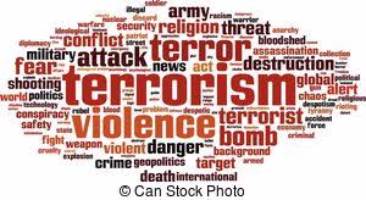Summary
Students will create a definition of terrorism and articulate in a more complex way an understanding of terrorism and issues regarding terrorism. Students will create an oral presentation of terrorist events and their ideological causes.
Essential Question(s)
What is terrorism? How does terrorism differ from planned acts of military aggression? Why do people commit acts of terror?
Snapshot
Engage
Students will brainstorm a beginning definition of terrorism and review definitions of terrorism from various sources.
Explore
Students will create a group definition of terrorism and come to a consensus about what terrorism is.
Explain
Students will identify whether certain events constitute terrorism or not.
Extend
Student groups will investigate and present information about domestic and foreign terrorism events.
Evaluate
Oral presentations of terrorism events rubric will be used to evaluate presentations.
Materials
"Definitions for Terrorism" student handout (located in Attachments)
"Are These Acts of Terrorism?" student handout (located in Attachments)
"Oral Presentations Rubric" (located in Attachments)
"Are These Acts of Terrorism Teacher Answer Key (located in Attachments)
Teacher slides for lesson presentation ("Teacher Slides for What is Terrorism" PowerPoint is located in Attachments)
Student access to Internet and devices for research
Engage
Ask students individually (PowerPoint slide three) first to define terrorism or what terrorist acts are in a sentence or two in their notebooks or on a sheet of notebook paper. Students are to also give examples of terrorist acts to support their definition.
Display the instructions for the three corners activity on slide four (this is a variation of the instructional strategy Four Corners). Read the directions aloud to students and then display PowerPoint slide five with the two pictures.
Students will move to one of the corners of the room that they believe most represents "terrorism." Students discuss within their group why they chose to move where they did. Have each group choose a spokesperson to share why they chose their picture and explain their reasoning with the class.
Explore
Have students move back to their desks and number off into groups of three or four. Give students the handout titled, "Definitions of Terrorism." Students in the groups are to read the definitions of terrorism and come up with a group definition (in their OWN words) that adequately explains what terrorism is.
Once groups have finished, the class will use these definitions to create a whole-class word cloud using EdWordle. Have a person from each group type their definition into the word cloud. You could also have a student representative from each group bring their definitions to you for you to add to the whole-class word cloud. Process the group definitions to create a word cloud. Discuss as a class what common ideas are featured in the word cloud. Try to come up with a class consensus of the definition of terrorism. Conduct a BRIEF class discussion to ask the class as a whole, how is terrorism different from military aggression?
Ask students to look at the pictures again on slide five. Using the class's definition of terrorism and Poll Everywhere, have students decide again, whether pictures 1, 2, or both are pictures of terrorism. You could also just do a show of hands regarding the terrorist pictures and see if the numbers change. Another option is to ask the class aloud if the definitions changed anyone's minds about the pictures. Discuss whether anyone changed their answer to the "What is Terrorism?" slide based on the discussion.
Explain
Pass out the "Are These Actions Terrorism?" handout to all students and read aloud the directions. Allow students to continue to work together in groups. With their group, students are to discuss and to determine whether the following actions are "terrorist" acts through the class definition and the terrorism definitions handout. Allow 30 minutes for this activity. A teacher answer key with explanations is provided.
At this point, students can turn in this paper for a grade or correct their own paper using the PowerPoint slides six and seven. If you want a grade for this paper, you can have students turn in the assignment first and then review the correct answers on the PowerPoint slides.
Extend
Groups will be assigned an identified terrorist act for research. Number groups randomly one through seven. Show PowerPoint slide eight, which explains the oral presentation project. Slide nine lists international and domestic terrorist acts. Groups will research the terrorist event associated with their number on slide nine. Depending on class size, more than one group may research the same event.
Pass out the "Oral Presentation Rubric" (located under Attachments) to all group members. Discuss the presentation rubric in detail prior to students beginning their research. Determine what assessment value the oral presentation will have for your class. Determine what product the presentation will be: PowerPoint, Google Slides, or Prezi; chart tablet or poster; or maybe a "news" video about the event. If students produce a news video, require that they turn in a written script in addition to their Internet sources.
Evaluate
The "Are These Actions Terrorism?" worksheet and the oral presentations will serve as assessments for this lesson.
Resources
28 C.F.R. § 0.85 (2017).
ACLU. (n.d.). How the USA Patriot Act redefines "domestic terrorism." https://www.aclu.org/other/how-usa-patriot-act-redefines-domestic-terrorism
Convention for the Prevention and Punishment of Terrorism (1937). League of Nations publication. https://www.wdl.org/en/item/11579/
Council of the European Union. (2002). Council framework decision of 13 June 2002 on combating terrorism. EUR-Lex: Access to European Law. http://eur-lex.europa.eu/legal-content/EN/ALL/?uri=CELEX:32002F0475
Federal Bureau of Investigation Counterterrorism Division. (n.d.). Terrorism: 2002-2005. https://www.fbi.gov/stats-services/publications/terrorism-2002-2005
K20 Center. (n.d.). EdWordle. Tech Tools. https://learn.k20center.ou.edu/tech-tool/693
K20 Center. (n.d.). Four Corners. Strategies. https://learn.k20center.ou.edu/strategy/138
K20 Center. (n.d.). Poll Everywhere. Tech Tools. https://learn.k20center.ou.edu/tech-tool/662
Office of the Coordinator for Counterterrorism. (2003). Patterns of global terrorism. https://www.state.gov/j/ct/rls/crt/2002/html/19977.htm
Terrorism. (2017). In Merriam-Webster’s dictionary. https://www.merriam-webster.com/dictionary/terrorism
Terrorism. (2017). In Dictionary.com. http://www.dictionary.com/browse/terrorism
U.S. Department of State. (2005). Chapter 1: Legislative requirements and key terms. Country Reports on Terrorism. https://www.state.gov/j/ct/rls/crt/2005/


